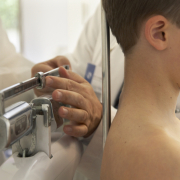Scoliosis and pregnancy
For a woman, discovering she is pregnant is often one of the most memorable, most exciting and happiest moments in her life. Thinking about the baby, imagining it and talking about it, not to mention feeling it inside her, arouses a number of precious and positive emotions: hope, tenderness and love. However, at the same time, pregnancy leads to various changes, in her body, her self-image and her vision of the future.
Furthermore, she will need to make adjustments and seek new balances in her (often busy) daily life, her rhythms and her relations with others.
All this can generate normal and entirely understandable fears, and these can be amplified in mothers-to-be who happen to be affected by a condition like scoliosis. Many such women will already have expressed anxiety over their ability to conceive, carry and give birth to a child.
Pregnancy and childbirth, on account of the physical demands they make, can indeed be quite a daunting prospect for these women.
An interesting recent review of the literature (Dewan MC, Mummareddy N, Bonfield C. The influence of pregnancy on women with adolescent idiopathic scoliosis. Eur Spine J. 2018 Feb;27(2):253-263. doi: 10.1007/s00586-017-5203-7. Epub 2017 Jun 29. PMID: 28664223.), focusing on the interaction between pregnancy and scoliosis, examines these very issues. Just to give an idea, in numerical terms, of the analysis carried out, this review included 134 articles and examined 22 studies, referring to a total of 3125 patients.
First of all, the review considered whether and how scoliosis affects the timing and outcomes of pregnancy. It would appear that women with idiopathic scoliosis need not worry about their possibility of having children, even though they have a slightly lower probability of becoming pregnant compared with age-matched women, and may be slightly more likely to receive fertility treatment. Furthermore, women with scoliosis, regardless of whether they underwent surgery or bracing treatment, can expect to have a similar number of children as healthy women.
However, the studies considered have certain limitations: most of them failed to specify whether the women with scoliosis had been actively seeking or desired pregnancy. Similarly, it is not clear whether all the patients were followed up until menopause. Furthermore, marriage rates, often not even mentioned, were not uniform across the studies.
In the absence of indications on these aspects, the slightly higher rate among women with scoliosis who do not have children could be misinterpreted.











Leave a Reply
Want to join the discussion?Feel free to contribute!